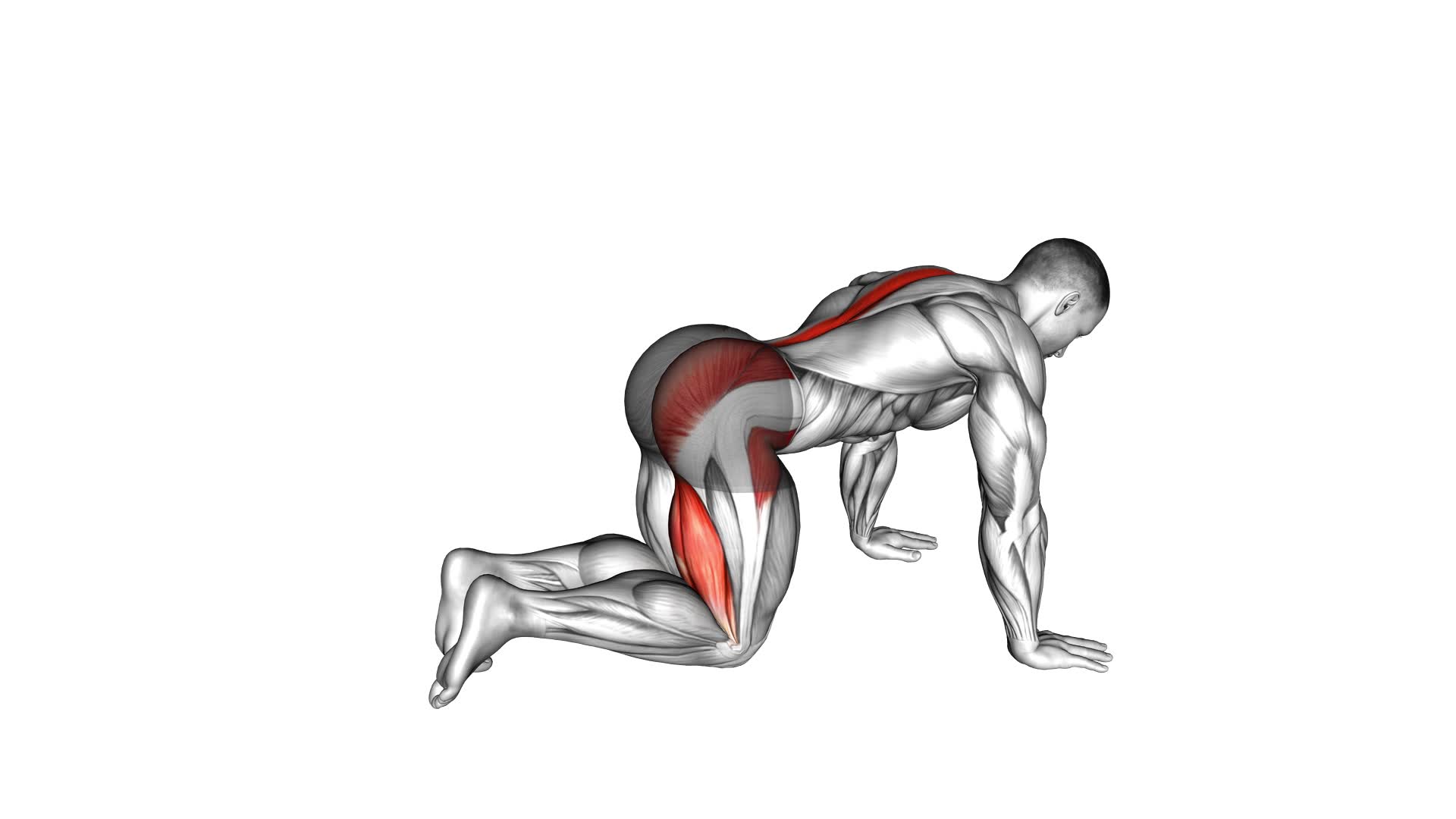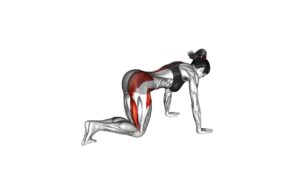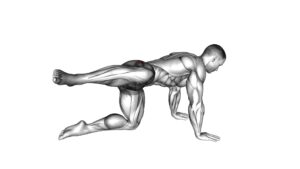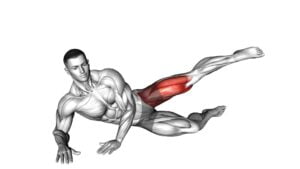Bent Knee Back to Side Kick (male) – Video Exercise Guide & Tips

In this article, you'll learn all about the Bent Knee Back to Side Kick exercise. This powerful move targets your legs and core, helping to build strength and improve stability.
Watch This Exercise Video
We'll guide you through the proper form and technique, as well as provide variations and progressions to challenge yourself. Avoid common mistakes and maximize the effectiveness of this kick with our expert tips.
Plus, we've included a sample workout routine incorporating this exercise for you to try.
Let's get started!
Key Takeaways
- Targets multiple muscle groups in the lower body
- Improves core strength and stability
- Tones abdominal muscles and improves posture
- Increases hip flexibility
Benefits of the Bent Knee Back to Side Kick
You will experience several benefits from incorporating the Bent Knee Back to Side Kick into your workout routine. This exercise targets multiple muscle groups, providing a well-rounded workout for your lower body. One of the main benefits is improved core strength and stability. As you perform the kick, you engage your abdominal muscles to maintain balance and control. This not only helps tone your abs but also improves your overall posture.
Another benefit of the Bent Knee Back to Side Kick is increased hip flexibility. The movement requires a good range of motion in your hips, which can be improved through regular practice. This can be especially beneficial for athletes or individuals who participate in sports that involve running, jumping, or kicking.
Proper form is crucial to maximize the benefits of this exercise. Start by standing with your feet shoulder-width apart and your hands on your hips. Lift one leg, bending the knee at a 90-degree angle. From there, kick the leg back and then to the side, keeping it straight throughout the movement. Return to the starting position and repeat on the other side.
Incorporating the Bent Knee Back to Side Kick into your workout routine won't only help you build strength and flexibility but also enhance your overall physical performance.
Proper Form and Technique
To ensure maximum effectiveness and safety, it's important to maintain proper form and technique while performing the Bent Knee Back to Side Kick exercise. By following these guidelines, you can improve flexibility and prevent injuries:
- Start by standing with your feet shoulder-width apart and your knees slightly bent.
- Lift your right knee up towards your chest, keeping your abs engaged for stability.
- Extend your right leg backward, kicking it out to the side at a 45-degree angle.
- As you kick, maintain a straight back and avoid leaning forward or backward.
- Return to the starting position by bringing your right knee back towards your chest and then lowering your foot to the ground.
Variations and Progressions
After mastering the proper form and technique of the Bent Knee Back to Side Kick exercise, you can explore various variations and progressions to challenge yourself further and continue improving your flexibility and lower body strength. Adding variations to your routine not only keeps things interesting but also targets different muscle groups and enhances the overall effectiveness of the exercise.
One variation you can try is the Straight Leg Back to Side Kick. Instead of bending your knee, keep your leg straight throughout the movement. This variation places more emphasis on your hamstrings and glutes, providing a greater stretch and strengthening effect.
Another modification is the Weighted Back to Side Kick. Hold a dumbbell or kettlebell in your hand while performing the exercise to increase resistance and further engage your muscles. Start with a lighter weight and gradually increase it as you become more comfortable and proficient.
For an advanced progression, you can attempt the Jumping Back to Side Kick. Begin in a squat position, then explosively jump up while performing the back to side kick. This variation adds a plyometric element, challenging your explosive power and coordination.
Remember to always maintain proper form and technique when attempting these variations and modifications. Start with the basic exercise and gradually progress to more challenging variations as you build strength and flexibility.
Common Mistakes to Avoid
To perform the Bent Knee Back to Side Kick exercise correctly and avoid common mistakes, it's important to focus on proper knee alignment.
Make sure your knee stays in line with your hip throughout the movement to prevent any strain or injury.
Additionally, engaging your core muscles will help maintain stability and control during the exercise.
Lastly, remember to perform the movements slowly and with control to maximize effectiveness and minimize the risk of incorrect form.
Proper Knee Alignment
Ensure proper alignment of your knee to avoid common mistakes during the Bent Knee Back to Side Kick exercise. Knee injury prevention and muscle activation are crucial aspects to consider. Here are some tips to help you maintain proper knee alignment:
- Align your knee with your toes: Make sure your knee is pointing in the same direction as your toes to avoid unnecessary stress on the joint.
- Keep your knee in line with your hip: Ensure that your knee is stacked directly above your hip to maintain proper alignment and stability.
- Avoid excessive inward or outward rotation: Be mindful of any excessive rotation of the knee, as it can lead to strain or injury.
- Engage your quadriceps and hamstrings: Activate these muscles to provide support and stability to the knee joint.
- Land softly and absorb impact: When performing the kick, aim to land softly and absorb the impact to reduce stress on the knee.
By focusing on proper knee alignment, you can minimize the risk of injury and maximize muscle activation during the Bent Knee Back to Side Kick exercise.
Now, let's move on to engaging core muscles.
Engaging Core Muscles
To effectively engage your core muscles during the Bent Knee Back to Side Kick exercise, focus on maintaining stability and activating your abdominal muscles. Engaging your core muscles not only helps you maintain balance and control during the exercise, but it also has numerous benefits for your overall fitness.
When you engage your core, you strengthen the muscles in your abdomen, including the obliques, which are responsible for side-to-side movements and rotational stability. Strong obliques can improve your athletic performance and help prevent injuries.
Additionally, engaging your core helps improve your posture and stability in everyday activities. To engage your core effectively, imagine pulling your belly button towards your spine and contracting your abdominal muscles throughout the exercise.
Slow and Controlled Movements
You need to focus on maintaining slow and controlled movements to avoid common mistakes during the Bent Knee Back to Side Kick exercise. Slow and controlled movements are important for several reasons.
First, they allow you to fully engage your muscles and maintain proper form throughout the exercise. Second, they help improve your flexibility, as you're able to stretch and extend your leg in a controlled manner. Third, slow and controlled movements have a significant impact on your lower body strength. By performing the exercise in a controlled manner, you're able to target and engage the muscles in your legs and glutes more effectively. Lastly, slow and controlled movements reduce the risk of injury by allowing you to focus on proper technique and alignment.
By understanding the importance of slow and controlled movements, you can maximize the effectiveness of the Bent Knee Back to Side Kick exercise.
Now, let's move on to some tips for maximizing the effectiveness of this exercise.
Tips for Maximizing the Effectiveness
To maximize the effectiveness of the Bent Knee Back to Side Kick exercise, it's crucial to focus on correct body alignment and breathing techniques.
Maintaining proper alignment, such as keeping your core engaged and shoulders relaxed, will ensure that you target the correct muscles and avoid strain or injury.
Additionally, utilizing proper breathing techniques, such as exhaling during the exertion phase of the kick, will help increase efficiency and power in your movements.
Correct Body Alignment
Achieving proper alignment is crucial for maximizing the effectiveness of the Bent Knee Back to Side Kick exercise. To ensure correct body posture and muscle engagement, follow these tips:
- Stand tall with your feet hip-width apart.
- Keep your core engaged and your shoulders relaxed.
- Bend your supporting leg slightly and shift your weight onto it.
- Maintain a neutral spine by keeping your chest lifted and your back straight.
- As you perform the kick, keep your hips squared and avoid rotating them.
Breathing Techniques for Efficiency
Maintaining proper breathing techniques enhances the efficiency and effectiveness of the Bent Knee Back to Side Kick exercise. By focusing on your breath, you can improve your overall performance and maximize the benefits of this exercise.
One important breathing technique to remember is to exhale forcefully as you kick your leg out to the side. This helps to engage your core and stabilize your body, allowing for a more powerful and controlled movement.
Inhaling deeply before each kick and exhaling fully during the kick also helps to oxygenate your muscles and increase endurance.
Sample Workout Routine Incorporating the Kick
When incorporating the Bent Knee Back to Side Kick into your workout routine, make sure to start with a proper warm-up. This will help prepare your muscles for the activity ahead and reduce the risk of injury.
Once you're warmed up, you can begin integrating the kick into your workout. Here is a sample routine to help you get started:
- Perform 2 sets of 10 reps on each leg, alternating sides.
- Rest for 30 seconds between sets to allow for recovery.
- Increase the number of sets and reps as you become more comfortable with the exercise.
- To modify the workout, you can decrease the range of motion by bending your knee less or perform the kick on a stability ball for added challenge.
- Focus on muscle activation during the kick by engaging your glutes, hamstrings, and core throughout the movement.
Remember to listen to your body and adjust the workout according to your fitness level. It's important to maintain proper form and control during the Bent Knee Back to Side Kick to maximize its benefits.
Frequently Asked Questions
How Long Does It Typically Take to Master the Bent Knee Back to Side Kick?
To master the bent knee back to side kick, it typically takes time and practice. The key is to start with proper warm up exercises to prepare your body and increase flexibility.
Focus on strengthening your core and leg muscles to improve stability and power. With consistent training and dedication, you can gradually improve your technique and master this kick.
Remember to always listen to your body and progress at your own pace.
Are There Any Specific Warm-Up Exercises Recommended Before Attempting This Kick?
Before attempting the Bent Knee Back to Side Kick, it's crucial to warm up properly. Specific warm-up exercises can help prepare your muscles and joints for the kick.
Incorporating dynamic stretches, such as leg swings and hip rotations, can increase your range of motion and flexibility. Additionally, performing light cardiovascular activities like jogging or jumping jacks can increase blood flow and warm up your entire body.
These warm-up exercises have numerous benefits, including reducing the risk of injury and improving overall performance.
Can the Bent Knee Back to Side Kick Be Modified for Beginners or Individuals With Limited Flexibility?
Yes, the bent knee back to side kick can be modified for beginners or individuals with limited flexibility.
To start, you can practice the kick with a lower range of motion, gradually increasing it as you become more comfortable.
Another modification is to perform the kick with a bent knee throughout the movement, instead of fully extending the leg. This allows for a smaller range of motion and reduces strain on the muscles.
Remember to progress at your own pace and listen to your body.
Are There Any Specific Muscles That Are Targeted More During This Kick?
During the bent knee back to side kick, several specific muscle groups are targeted. The kick primarily engages the gluteus maximus, which is responsible for hip extension. Additionally, the quadriceps, hamstrings, and hip abductors are activated to stabilize and control the movement.
This kick is great for improving flexibility as it requires a wide range of motion in the hips and legs. You'll feel the burn in your muscles and see increased flexibility with regular practice.
Can the Bent Knee Back to Side Kick Be Incorporated Into Other Forms of Exercise or Martial Arts Routines?
Incorporating the bent knee back to side kick into other forms of exercise or martial arts routines can add variety and challenge to your workouts. This dynamic movement targets your glutes, hamstrings, and core muscles, improving strength and stability.
You can modify the kick by adjusting the height and speed, or combining it with other kicks and strikes for a more comprehensive workout. It's a great way to enhance your martial arts skills and overall fitness level.
Conclusion
Incorporating the bent knee back to side kick into your workout routine can offer a range of benefits. This exercise can improve core strength, flexibility, and balance. By maintaining proper form and technique, you can maximize the effectiveness of this exercise. It is important to avoid common mistakes such as leaning too far back or failing to engage your core. These mistakes can reduce the effectiveness of the exercise and increase the risk of injury. With variations and progressions, you can challenge yourself and continue to progress in your fitness journey. Add this kick to your routine for a dynamic and effective workout.

Author
Years ago, the spark of my life’s passion ignited in my mind the moment I stepped into the local gym for the first time. The inaugural bead of perspiration, the initial endeavor, the very first surge of endorphins, and a sense of pride that washed over me post-workout marked the beginning of my deep-seated interest in strength sports, fitness, and sports nutrition. This very curiosity blossomed rapidly into a profound fascination, propelling me to earn a Master’s degree in Physical Education from the Academy of Physical Education in Krakow, followed by a Sports Manager diploma from the Jagiellonian University. My journey of growth led me to gain more specialized qualifications, such as being a certified personal trainer with a focus on sports dietetics, a lifeguard, and an instructor for wellness and corrective gymnastics. Theoretical knowledge paired seamlessly with practical experience, reinforcing my belief that the transformation of individuals under my guidance was also a reflection of my personal growth. This belief holds true even today. Each day, I strive to push the boundaries and explore new realms. These realms gently elevate me to greater heights. The unique combination of passion for my field and the continuous quest for growth fuels my drive to break new ground.







